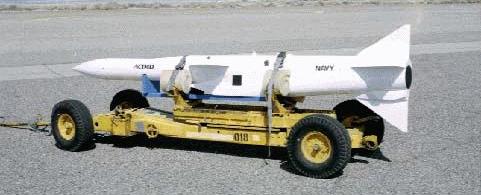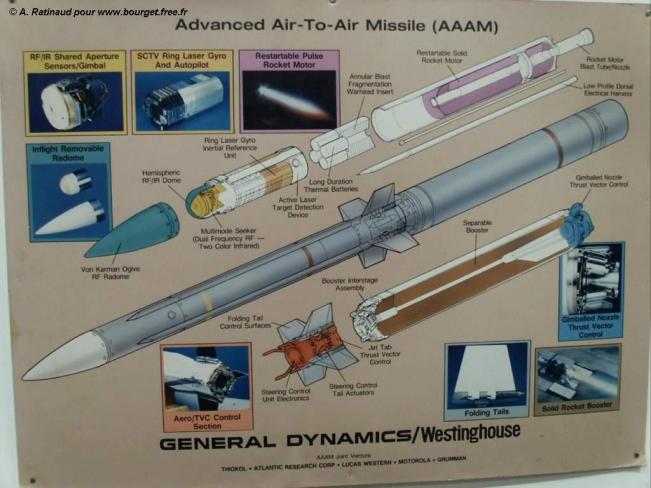AIM-152 AAAM
In the mid-1980s the U.S. Navy had a requirement for an advanced long-range air-to-air missile to replace the aging AIM-54 Phoenix. The projected AAAM (Advanced Air-to-Air Missile) was to be significantly smaller and lighter than the Phoenix, but was to have a longer range and a speed of at least Mach 3. Some key technologies for these goals (like integral rocket/ramjet propulsion and multimode (radar/IR) guidance) had been evaluated by the U.S. Naval Weapons Center (NWC) at China Lake during 1983 in the ACIMD (Advanced Common Intercept Missile Demonstration) program. ACIMD test missiles were built, but not flown before program cancellation. In late 1987, two contractor teams were selected as finalists for AAAM evaluation, these being Hughes/Raytheon and General Dynamics/Westinghouse.
 |
| Photo: U.S. Navy |
| ACIMD missile |
The Hughes/Raytheon AAAM was based on the ACIMD design, and used a hybrid solid-rocket/ramjet propulsion system which offered higher speeds at maximum range. It was designed to use an inertial mid-course guidance with command updates (similar to the AIM-120 AMRAAM), and a dual-mode (active-radar/infrared) seeker for terminal homing.
 |
| Image: Hughes/Raytheon |
| YAIM-152A (Hughes/Raytheon design) |
GD/Westinghouse offered a significantly smaller design using a multiple-pulse solid-propellant rocket motor for propulsion. It had an inertial navigation system with dual-band semi-active radar homing for mid-course guidance and an electro-optical sensor for autonomous terminal homing. A backup IR seeker was also envisioned in case the primary EO guidance would fail. The launching aircraft would use a targeting pod with forward and aft radar so that the aircraft would not need to fly towards the target to illuminate it.
 |
| Photo: Alain Ratinaud |
| YAIM-152A (GD/Westinghouse design) |
The AAAM was planned in the late 1980s as defense against Soviet Tu-22M Backfire and Tu-160 Blackjack long-range supersonic bombers. However, after the end of the Cold War this threat has effectively vanished and therefore the AAAM program was cancelled in 1992, before any of the designs had been selected for development. Shortly before cancellation, the official designation YAIM-152A had been allocated to the projected AAAM prototypes (the designation "AIM-155" as used in source [3] is definitely incorrect). Since the termination of AAAM, the U.S. Navy relies on longer-range developments of the AIM-120 AMRAAM (like the AIM-120C-7) to replace the AIM-54 Phoenix from about 2007.
Specifications
No YAIM-152A missiles were ever built. Figures given below are estimates and/or design requirements.
Data for YAIM-152A:
| Length | 3.66 m (12 ft) |
| Diameter | Hughes/Raytheon: 23 cm (9 in) GD/Westinghouse: 14 cm (5.5 in) |
| Weight | Hughes/Raytheon: < 300 kg (660 lb) GD/Westinghouse: 172 kg (380 lb) |
| Speed | Mach 3+ |
| Range | > 185 km (100 nm) |
| Propulsion | Hughes/Raytheon: integral rocket/ramjet engine GD/Westinghouse: multiple-pulse solid-propellant rocket |
| Warhead | 14-23 kg (30-50 lb) blast-fragmentation |
Main Sources
[1] Norman Polmar: "The Naval Institute Guide to the Ship and Aircraft of the U.S. Fleet", 15th ed., Naval Institute Press, 1993
[2] Bernard Blake (ed.): "Jane's Weapon Systems 1987-88", Jane's, 1988
[3] Ruud Deurenberg: "Advanced Air-to-Air Missile (AAAM)", 1998
Back to Current Designations Of U.S. Unmanned Military Aerospace Vehicles
Back to
Directory of U.S. Military Rockets and Missiles
Last Updated: 19 January 2003